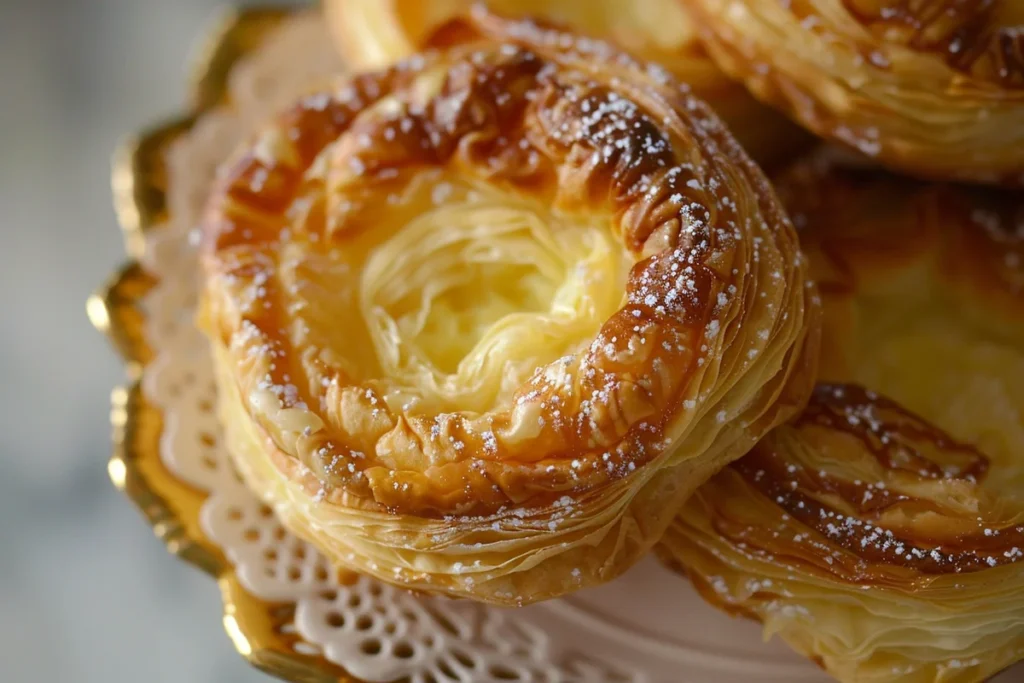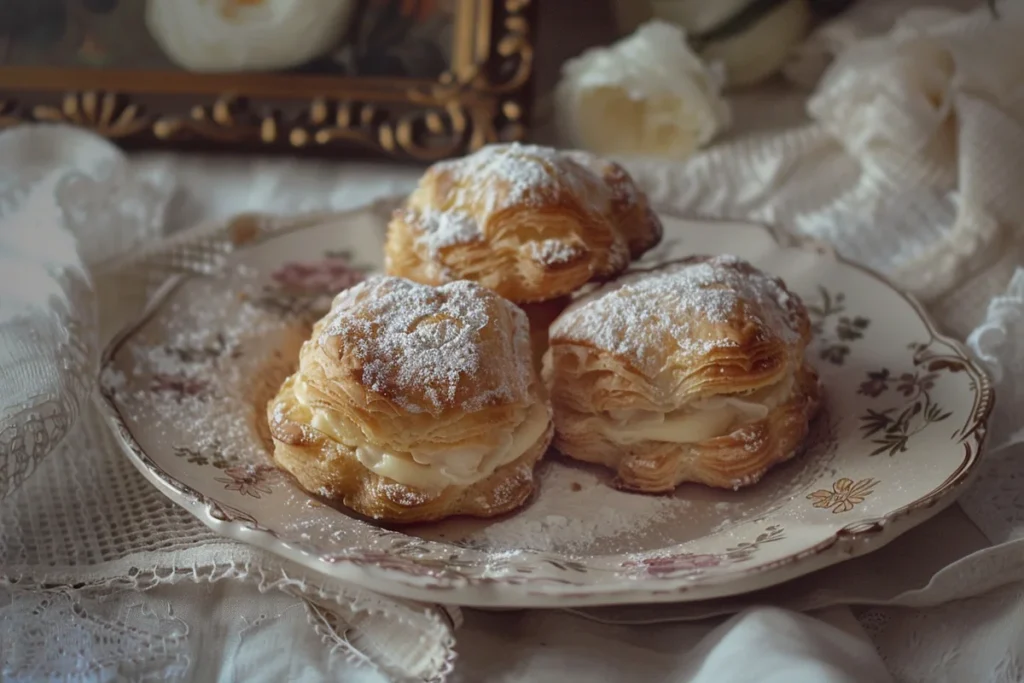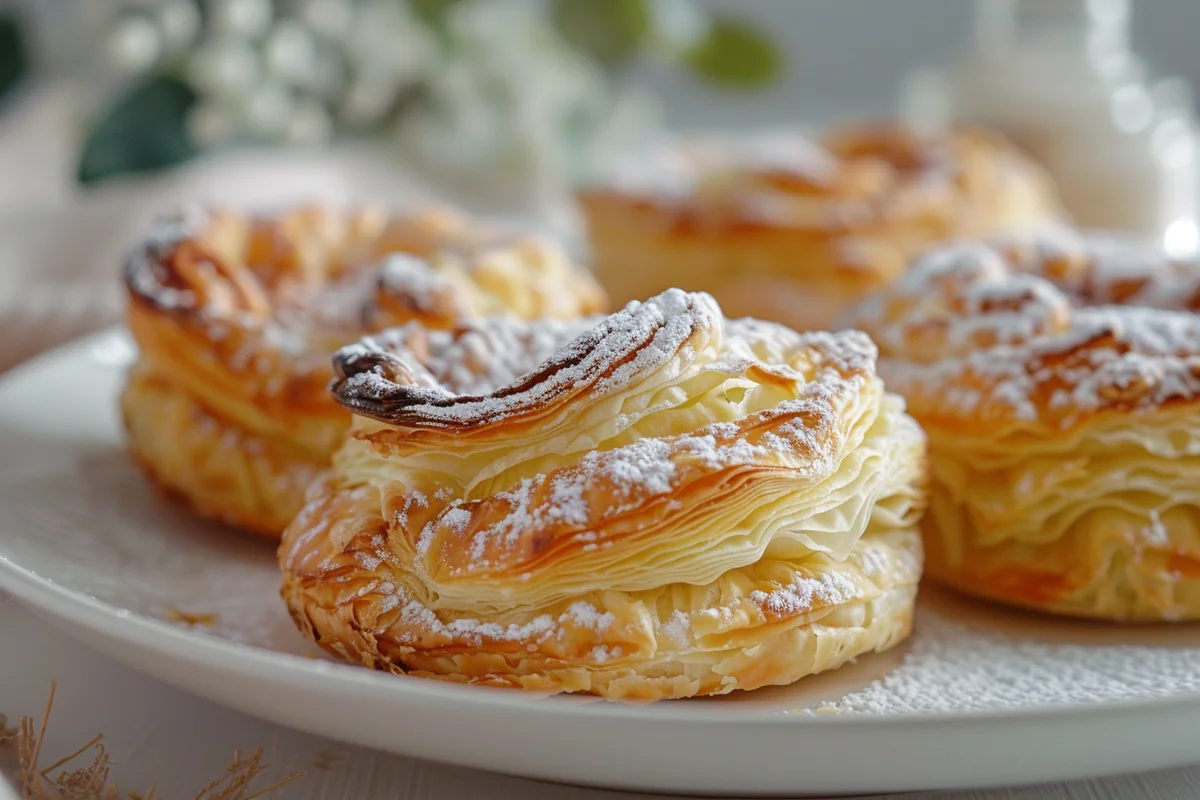Puff pastry is a wonderfully flaky and light dough commonly used in both sweet and savoury dishes. One question that comes up often for both new and seasoned bakers is this: Do you bake puff pastry before filling it? Understanding when and why to bake your puff pastry before adding the Filling can make a significant difference in the outcome of your recipes.
In this comprehensive guide, we’ll break down the answer to that question, along with tips and techniques for blind baking, avoiding soggy pastry, and making sure your puff pastry turns out perfectly crisp and golden every time.
What Is Puff Pastry?
Puff pastry is a laminated dough made by layering dough and butter, which results in a light, flaky texture when baked. The process of laminating the dough involves rolling and folding it multiple times, which creates hundreds of thin layers. As it bakes, the water in the butter turns to steam, pushing the layers apart and making the dough puff up.
- Puff pastry is highly versatile and used in dishes like:
- Savoury pies and quiches
- Tarts and turnovers
- Croissants and pastry twists
There are two main types of puff pastry: traditional and rough puff. Traditional puff pastry requires several rounds of rolling and chilling, while rough puff is a quicker method that still delivers good results, though the layers could be more distinct.
The Process of Making Puff Pastry
The process of making puff pastry from scratch is time-consuming but rewarding. Here’s a quick breakdown:
- Make the Dough (Detrempe): Mix flour, water, and a small amount of butter to form a dough.
- Roll and Fold (Tourage): Incorporate a slab of butter, then roll and fold the dough multiple times.
- Chill Between Folds: It’s important to chill the dough after each fold to keep the butter from melting and to ensure a good rise.
If you’re not up for the challenge of making your puff pastry, don’t worry—store-bought puff pastry works just as well and saves time.
Do You Bake Puff Pastry Before Filling?
So, do you bake puff pastry before filling? The answer depends largely on the type of recipe you’re making. In some cases, it’s crucial to bake or partially bake the pastry before adding the Filling, while in others, you can bake the filled pastry all at once.
When to Bake Puff Pastry Before Filling:
- Wet Fillings: If your Filling contains a lot of moisture, like in a quiche or fruit tart, pre-baking (or blind baking) helps ensure the pastry doesn’t become soggy.
- Custard-based Fillings: Quiches or tarts with custard or liquid fillings often require a crisp pastry shell, which is best achieved through pre-baking.
- Savoury Pies: When making savoury pies with pre-cooked fillings, pre-baking the pastry can prevent the bottom from getting too soft.
When You Don’t Need to Pre-Bake:
- Turnovers and Hand Pies: These small pastries typically don’t require pre-baking since the fillings are relatively dry and the baking time is short.
- Sausage Rolls: Because the Filling is already cooked or dry, sausage rolls don’t need the extra step of blind baking.
What Is Blind Baking?
Blind baking is a technique where you bake the puff pastry (or any pastry) without any filling. This process helps create a stable, crisp crust, especially for recipes that require a liquid or wet filling. Blind baking is particularly useful when making pies, tarts, or quiches, where you want to avoid sogginess.
How to Blind Bake Puff Pastry:
- Dock the Dough: Use a fork to prick small holes in the dough. This prevents the pastry from puffing up too much.
- Use Pie Weights: To prevent the dough from shrinking or puffing unevenly, cover the pastry with parchment paper and fill it with pie weights (or dried beans).
- Partial or Full Baking: Depending on your recipe, you might only need to partially bake the pastry before adding the Filling, or you might need to bake it fully if the Filling isn’t baked afterwards.
Learn more about the blind baking process here.

Recipes That Require Pre-Baking Puff Pastry
Some dishes rely on the structure that pre-baking puff pastry provides. Here are a few common examples:
- Quiches:
A quiche is a savoury tart filled with a custard base (usually eggs and cream). The crust needs to be crisp and sturdy to hold the liquid filling, so pre-baking the puff pastry is essential.
- Fruit Tarts:
For fruit tarts, especially those with juicy fruits like berries or apples, pre-baking helps prevent the bottom of the pastry from becoming soggy.
- Savoury Tarts and Pies:
In dishes like a vegetable tart or a chicken pot pie, the puff pastry is often blind-baked to ensure a crisp bottom crust, even if the Filling is fully cooked or semi-cooked before baking.
Filling Puff Pastry Without Pre-Baking
In some cases, you don’t need to pre-bake puff pastry before adding the Filling. This is common in recipes where the Filling is either dry or fully cooked before it’s placed inside the pastry. These dishes usually bake quickly enough that the pastry doesn’t need to be pre-baked to become golden and flaky.
Tips for Baking Filled Puff Pastry:
- Use a Thicker Filling: If your Filling is thick (such as a creamy cheese filling), you don’t need to worry about it seeping through the layers of pastry.
- High Oven Temperature: Baking puff pastry at a high temperature (around 400°F-425°F) ensures that the layers puff up and become crisp before the Filling has a chance to make the pastry soggy.
- Egg Wash: Brushing the edges of the pastry with an egg wash helps seal the Filling inside and gives the pastry a glossy, golden finish.
How to Prevent Soggy Puff Pastry
Nobody likes a soggy pastry bottom! To keep your puff pastry light and crisp, especially when using wet fillings, follow these steps:
- Drain Your Fillings: For ingredients like tomatoes or spinach, make sure to drain or pre-cook them to remove excess moisture.
- Use a Thickener: If you’re using a fruit filling, add a thickening agent like cornstarch or flour to absorb extra liquid.
- Cook the Filling Separately: Pre-cooking ingredients like meats or vegetables helps remove excess water before adding them to the pastry.
- Bake at the Right Temperature: A hot oven allows the puff pastry to bake quickly, sealing the layers and preventing sogginess.
The Role of Temperature in Puff Pastry Baking
The baking temperature of puff pastry is one of the most critical factors in ensuring a perfect rise and flaky layers.
High Heat Is Key:
Puff pastry should always be baked in a hot oven, usually between 400°F and 425°F. The high heat causes the water in the butter to evaporate quickly, creating steam that lifts the layers of dough. If the oven temperature is too low, the butter will melt slowly and seep into the dough, making the pastry heavy and greasy rather than light and crisp.
Troubleshooting Common Puff Pastry Problems
Even with the best intentions, puff pastry doesn’t always turn out the way we want it to. Here are some common issues and how to solve them:
Why Is My Puff Pastry Soggy?
This usually happens if the Filling is too wet or the oven temperature isn’t hot enough. Try pre-cooking the Filling or blind baking the pastry to avoid this problem.
Why Did My Puff Pastry Collapse?
Puff pastry can collapse if the butter in the dough isn’t kept cold enough. Be sure to chill the pastry between folds and before baking.
Why Did My Puff Pastry Bake Unevenly?
Uneven puff pastry usually results from inconsistent rolling. Make sure the dough is rolled to an even thickness to avoid some sections puffing more than others.
Baking Puff Pastry for Sweet vs. Savory Dishes
While puff pastry can be used for both sweet and savoury recipes, there are a few differences in how you should approach baking for each:
Sweet Dishes:
- Sweet puff pastry recipes, such as fruit tarts or danishes, often need less time in the oven. You’ll want to bake the pastry until it’s golden but not overcooked, as fillings like cream or fruit can continue to cook the pastry slightly after it’s removed from the oven.
Savory Dishes:
- Savoury dishes, like pies and tarts with vegetables or meat, often require a longer baking time. The key is to make sure the Filling is cooked through while ensuring the pastry remains crisp and flaky.

Freezing and Storing Puff Pastry
Puff pastry is highly freezer-friendly, whether baked or unbaked. Here’s how to store it properly:
Freezing Unbaked Puff Pastry:
- Roll out the dough, then wrap it tightly in plastic wrap and place it in a freezer-safe bag. It can be frozen for up to 3 months.
Freezing Baked Puff Pastry:
- Once the pastry is baked, let it cool completely before wrapping it in plastic wrap. Baked puff pastry can also be frozen for up to 3 months, though it’s best when reheated in the oven, not the microwave.
Frequently Asked Questions (FAQs)
Can I fill puff pastry before baking?
Yes, you can fill puff pastry before baking, especially for dishes like turnovers or sausage rolls. Just ensure your filling is thick or dry to avoid making the pastry soggy.
How long should I bake puff pastry before adding filling?
If you’re blind baking puff pastry, bake it for 10-15 minutes until lightly golden before adding the filling.
Why is my puff pastry soggy after baking?
Your filling might be too wet, or you didn’t bake the pastry at a high enough temperature. Pre-cooking the filling can help reduce moisture.
Can you bake puff pastry from frozen?
Yes, you can bake puff pastry directly from frozen. You may need to add a few extra minutes to the baking time.
Should I thaw puff pastry before baking?
Thawing puff pastry slightly before baking makes it easier to work with, but you can bake it straight from the freezer if you’re in a pinch.
Conclusion
Do you bake puff pastry before filling? The answer depends on your recipe. For liquid or wet fillings, pre-baking is crucial to prevent sogginess. For turnovers and similar dishes, you can bake everything together. By following the right techniques, such as blind baking, using thick fillings, and ensuring proper oven temperature, you’ll achieve perfectly flaky, golden puff pastry every time.

